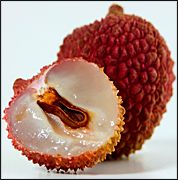Whether you accept it, avoid it or live somewhere in between, insurance coverage has become a defining issue for our profession. Patients increasingly expect to use their benefits, practitioners want to be compensated fairly for their time and expertise, and the system itself remains – at best – fragmented. The encouraging news is that coverage has expanded in meaningful ways. The challenging news is that reimbursement, across the board, remains inadequate.
Herbs & Botanicals
Leechee Nut (li zhi he)
What is leechee nut? What is it used for?
Also spelled "lychee," the leechee nut is not actually a nut at all, but a type of fruit that comes from the litchi, a tree native to southern China. The nuts, or fruits, grown in clusters of 20 to 30, with a pinkish-red exterior and a leathery skin. Underneath the skin is a clear, whitish flesh, which resembles the inside of a grape and covers a large seed.
The fruits dehydrate naturally, with the skin becoming brown and brittle, and the inner flesh becoming dry and shriveled, giving it the appearance of a nut. As a food source, the fruits are picked fresh, with the seed removed, and usually packed in heavy syrup. The seeds are used in herbal remedies.
 Leechee nuts have been used in traditional Chinese medicine for centuries; the first record of the medicinal uses of leechee nut date back to the 11th century. According to the principles of traditional Chinese medicine, leechee nut has sweet and warm properties, and is associated with the Liver and Stomach meridians. Its functions are to regulate qi and to treat a variety of pain, including abdominal pain, postpartum pain, and pain caused by premenstrual syndrome. Some practitioners also used leechee nut to treat diabetes and reduce blood sugar levels.
Leechee nuts have been used in traditional Chinese medicine for centuries; the first record of the medicinal uses of leechee nut date back to the 11th century. According to the principles of traditional Chinese medicine, leechee nut has sweet and warm properties, and is associated with the Liver and Stomach meridians. Its functions are to regulate qi and to treat a variety of pain, including abdominal pain, postpartum pain, and pain caused by premenstrual syndrome. Some practitioners also used leechee nut to treat diabetes and reduce blood sugar levels.
How much leechee nut should I take?
The typical dose of leechee nut is between six and 15 grams, ground into powder and taken with boiling water as part of a decoction.
What forms of leechee nut are available?
Fresh, canned leechee nuts can be found at some supermarkets, and are widely available at Asian markets and specialty stores. Dried, powdered leechee nut is also available at some herbal shops, as are leechee pastes.
What can happen if I take too much leechee nut? Are there any interactions I should be aware of? What precautions should I take?
The seed of the leechee nut contains a type of toxin; as such, it should be consumed with caution, and should not be eaten by women who are pregnant or breastfeeding. As always, make sure to consult with a licensed health care provider before taking leechee nut or any other herbal remedy or dietary supplement.
References
- Holcroft DM, Mitcham EJ. Postharvest physiology and handling of litchi (Litchi chinensis Sonn.). Postharvest Biol Technol 1996;9:265-281.
- Huang CJ, Wu MC. Differential effects of foods traditionally regarded as "heating" and "cooling" on prostaglandin E(2) production by a macrophage cell line. J Biomed Sci November-December 2002;9(6, pt 2):596-606.
- Subhadrabandhu S. Lychee and Longan Cultivation in Thailand. Bangkok: Rumthai Publications, 1990.
- Subhadrabandhu S, Yapwattanaphun C. Lychee and longan production in Thailand. Paper presented at the First International Symposium on Litchi and Longan, Guangzhou, China, June 19-23, 2000.
- Underhill SJR, Coates LM, Saks Y. Litchi. In: Mitra S (ed.). Postharvest Physiology and Storage of Tropical and Subtropical Fruits. Wallingford, UK: CAB International, 1997, pp. 191-208.


